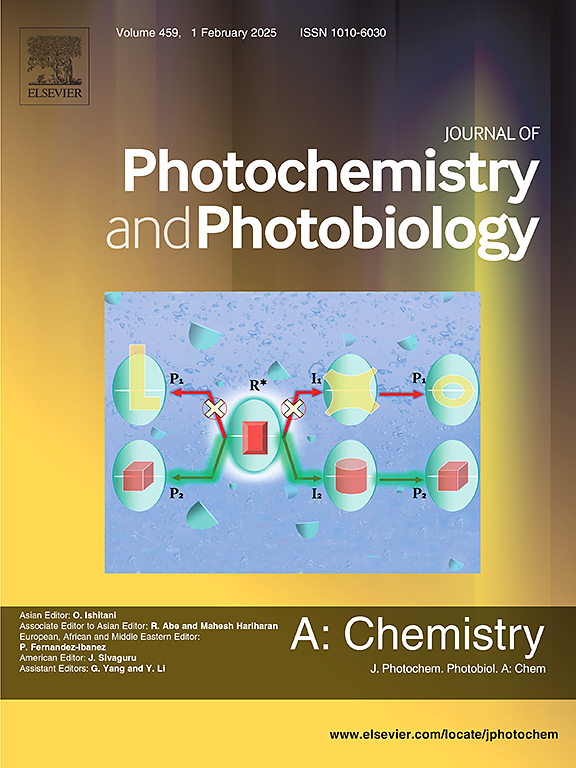Predicting 3D printing critical parameters from Basic photochemical principles in vat photopolymerization
IF 4.1
3区 化学
Q2 CHEMISTRY, PHYSICAL
Journal of Photochemistry and Photobiology A-chemistry
Pub Date : 2025-06-20
DOI:10.1016/j.jphotochem.2025.116572
引用次数: 0
Abstract
Vat photopolymerization technologies have emerged rapidly in the field of additive manufacturing. In this technology, the Jacobs working curve is considered the cornerstone for defining printing parameters. Understanding the underlying mechanisms occurring during 3D printing becomes mandatory. In this work, attempt was made to highlight the factors governing the critical energy and the depth of penetration. By systematically varying coinitiator concentrations in the isopropylthioxanthone (ITX) /coinitiator system —and thus modifying photopolymerization efficiency— we investigate their influence on maximum conversion, polymerization rate, and critical energy (Ec). A central finding is the direct correlation between inhibition time, quantum yield of radicals, and critical energy, establishing a predictive framework for resin reactivity. The results indicate that inhibition time strongly dictates Ec, providing an improved understanding of polymerization initiation in oxygen-inhibited environments. Furthermore, while ITX achieves high efficiency when combined with coinitiators such as N-phenylglycine (NPG) or ethyldimethylaminobenzoate (EDB), it is shown that it can initiate the photopolymerization alone, although at lower extent. These findings offer valuable insights for optimizing resin formulations in vat photopolymerization 3D printing, where precise control over polymerization kinetics is essential for print fidelity, layer adhesion, and mechanical performance.

从还原光聚合的基本光化学原理预测3D打印的关键参数
还原光聚合技术在增材制造领域迅速兴起。在这项技术中,雅各布斯工作曲线被认为是定义印刷参数的基石。了解在3D打印过程中发生的潜在机制是必须的。在这项工作中,试图突出控制临界能量和穿透深度的因素。通过系统地改变异丙基硫氧蒽酮(ITX) /共引发剂体系中的共引发剂浓度,从而改变光聚合效率,我们研究了它们对最大转化率、聚合速率和临界能(Ec)的影响。一个中心发现是抑制时间,自由基量子产率和临界能量之间的直接关系,建立了树脂反应性的预测框架。结果表明,抑制时间强烈地决定了Ec,为氧抑制环境中聚合起始的理解提供了更好的理解。此外,当ITX与n -苯基甘氨酸(NPG)或乙基二甲氨基苯甲酸乙酯(EDB)等共引发剂结合时,ITX具有较高的效率,但其单独引发光聚合的程度较低。这些发现为优化还原光聚合3D打印中的树脂配方提供了有价值的见解,其中对聚合动力学的精确控制对于打印保真度、层粘结力和机械性能至关重要。
本文章由计算机程序翻译,如有差异,请以英文原文为准。
求助全文
约1分钟内获得全文
求助全文
来源期刊
CiteScore
7.90
自引率
7.00%
发文量
580
审稿时长
48 days
期刊介绍:
JPPA publishes the results of fundamental studies on all aspects of chemical phenomena induced by interactions between light and molecules/matter of all kinds.
All systems capable of being described at the molecular or integrated multimolecular level are appropriate for the journal. This includes all molecular chemical species as well as biomolecular, supramolecular, polymer and other macromolecular systems, as well as solid state photochemistry. In addition, the journal publishes studies of semiconductor and other photoactive organic and inorganic materials, photocatalysis (organic, inorganic, supramolecular and superconductor).
The scope includes condensed and gas phase photochemistry, as well as synchrotron radiation chemistry. A broad range of processes and techniques in photochemistry are covered such as light induced energy, electron and proton transfer; nonlinear photochemical behavior; mechanistic investigation of photochemical reactions and identification of the products of photochemical reactions; quantum yield determinations and measurements of rate constants for primary and secondary photochemical processes; steady-state and time-resolved emission, ultrafast spectroscopic methods, single molecule spectroscopy, time resolved X-ray diffraction, luminescence microscopy, and scattering spectroscopy applied to photochemistry. Papers in emerging and applied areas such as luminescent sensors, electroluminescence, solar energy conversion, atmospheric photochemistry, environmental remediation, and related photocatalytic chemistry are also welcome.

 求助内容:
求助内容: 应助结果提醒方式:
应助结果提醒方式:


